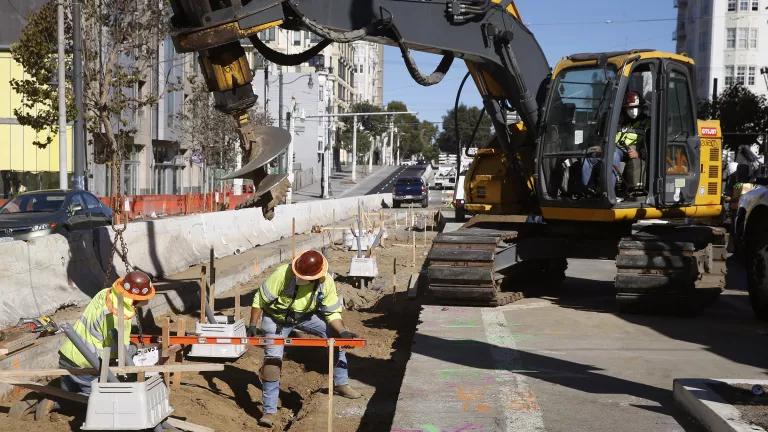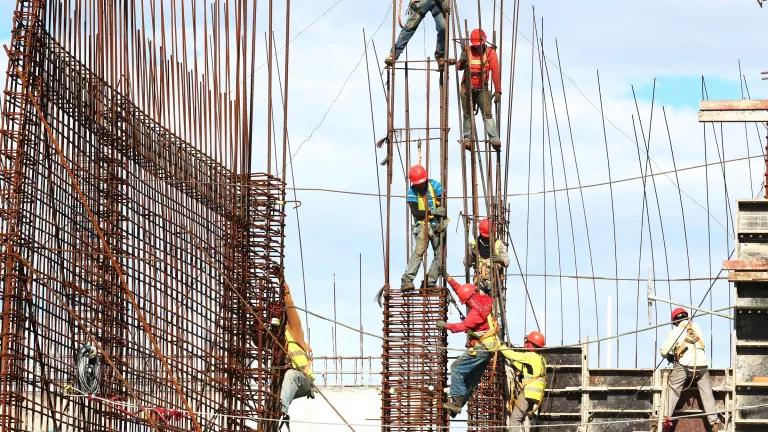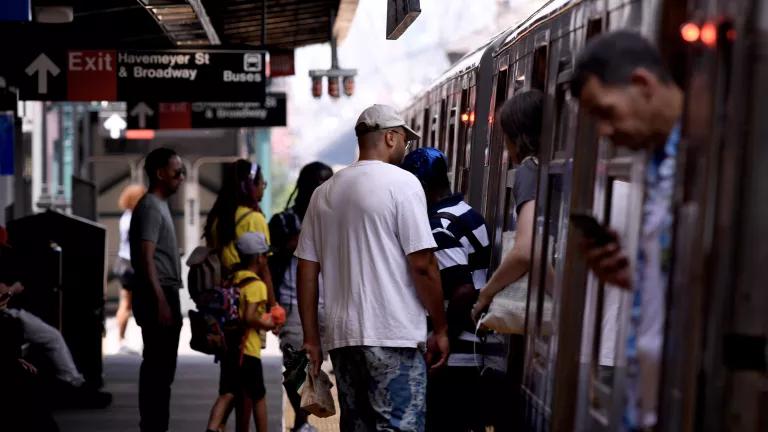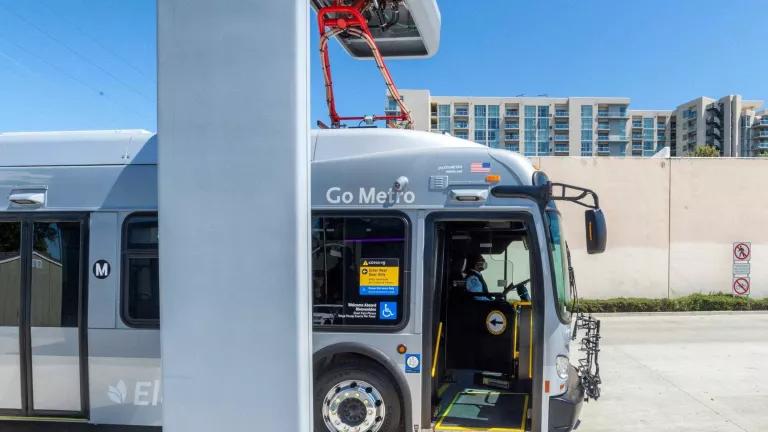A 21st-Century Transportation System That Drives Climate Action and Equitable Recovery
We must build the national transportation system of the future—and do it now, all while strengthening the responsible public oversight we all depend on to protect the environment and public health.

A bus rapid transit stop under construction in San Francisco
We must build the national transportation system of the future—and do it now, all while strengthening the responsible public oversight we all depend on to protect the environment and public health.
As congressional negotiations move forward on President Biden’s call to drive equitable recovery with climate action, it’s essential that we invest, as a nation, in revitalizing and upgrading the American transportation sector.
Getting this right will knit the country together in a modern system that makes it easier and more efficient for us to get to work, travel, and move goods. It will create millions of high-quality jobs.
It will make our economy more competitive, our communities healthier, and our society more equitable. And it will set us on the path to cutting the dangerous carbon pollution that’s driving us toward climate catastrophe—faster than we had feared.
Summer wildfires have already torched enough land to cover the state of Delaware, as record heat and drought turn vast reaches of the American West into tinderboxes ablaze with more than 70 active fires. The nation’s largest reservoir, Lake Mead, is two-thirds empty, the lowest level ever for the source of water for 25 million people. Some of the nation’s best pasture is baking to chalk, cattle ranchers are culling their herds, and grasshoppers are denuding croplands at rates not seen in decades.
All of this, and much more, gets worse, the science tells us, unless we cut the carbon pollution from burning coal, oil, and gas in half by 2030, and stop adding it to the atmosphere altogether by 2050.
Transportation has to be part of the fix. It’s the single-largest source of U.S. carbon pollution, accounting for 37 percent of the nation’s carbon footprint. Fortunately, there’s a lot we can do to reduce that pollution as part of Biden’s American Jobs Plan, a core piece of his call to Build Back Better for all people in the wake of the pandemic that’s upended the nation.
The starting point should be the INVEST Act that the House passed earlier this month to revitalize the nation’s bridges and roads, strengthen its passenger and freight rail system, improve access to safe drinking water, and much more.
The INVEST Act is a comprehensive five-year plan to transform the way we travel, commute, and transport goods. It’s about moving the country at the speed of the 21st century, and it deserves to be adopted in full.
As negotiations move forward, a Senate alternative, the Surface Transportation Reauthorization Act, is also on the table, though it hasn’t yet been passed by the full Senate. For this legislation to be a viable starting point for the transportation future we need, several key provisions must be added that will do the following:
- Prioritize projects that enhance equity and cut carbon pollution
Job one for a modern transportation system is to align new projects with our climate and equity goals. That means creating a system to measure the impact that any new transportation project will have on carbon pollution and racial equity. It means setting targets for progress in those areas from proposed projects. And it means prioritizing funding and providing other incentives for those projects that can do the most good when it comes to advancing equity and fighting the climate crisis.
- Boost investment in public transit
We all depend on access to safe and affordable transportation to get to work, advance our education, and otherwise connect with opportunities to improve our lives. Many of us, though, lack access to sustainable public transit, a problem that disproportionately impacts low-income and BIPOC communities.
One reason: Public transit gets just $1 in federal funding for every $4 that goes to highways. That’s wildly out of sync with the climate and equity action the country urgently needs. It flies in the face of the 77 percent of voters who want better transit options that reduce highway congestion and time wasted in traffic jams. And it’s out of step with the popularity of public transit investment at the local level: Voters approved 47 out of 53 public transit ballot measures just last year. It’s time to align spending with public priorities and boost investment in public transit.
- Speed the shift to zero-emissions vehicles
Cars, vans, and light trucks account for 57 percent of the transportation carbon footprint. We’ve got to cut tailpipe pollution 60 percent by 2030, and eliminate it in new vehicles by 2035, in order to meet our climate goals.
That means fully funding Biden’s call to support electric vehicles, by building half a million charging stations nationwide, as well as his plan to replace most of the aging federal fleet with electric cars and trucks. We must also support the transition to zero-emissions vehicles at the state and local levels with funding and other incentives for the facilities and workforce training this shift requires. And we must make sure low-income neighborhoods and communities of color have access to the benefits of zero-emissions vehicles.
- Fix the historic damage of urban highways
Decades ago, two generations of federal highway projects gutted scores of low-income and predominantly Black communities in cities across the country when major highways were routed in ways that split these neighborhoods, uprooting or stranding businesses, schools, churches, and homes, and exposing these communities to heightened air pollution, in devastating dislocations that endure to this day.
It’s past time to right these historic wrongs by investing in projects that help to tie these communities back together, restore the vibrant economic and social life they once supported, and create new opportunities to confront the legacy of racial injustice and inequity the nation is working to overcome.
- Ensure safe streets for everyone
With nearly 20 pedestrians or bicyclists killed, on average, every day, walking and biking are becoming increasingly dangerous along too many of our roads and highways, especially for Black, Indigenous, and other people of color. We can make our streets safer with modern roadway design standards. We need to fund safe byways for pedestrian and bicycle travel. And we need to ensure that states use bicycle and pedestrian funding for its intended purpose.
- Put safety and repair work first
Anyone who drives has encountered the inconvenience, and often the danger, of a national highway system in need of $435 billion worth of repairs. It’s essential that federal dollars go to fixing our broken highways before money is spent building new ones. That’s just common sense, but federal policy needs to make it explicit, to prevent money being spent on new roadways in areas where roads in poor condition already pose hazards, slow traffic, and put our people at risk.
- Enhance the role of local governments
From bike paths to bus routes, local governments best understand the needs of their communities and the opportunities for creating transportation systems that improve efficiency, sustainability, and equity. And yet, more than 99 percent of federal transportation funding is not directly available to local leaders. It is, instead, allocated mostly through states and, to a lesser degree, large municipal governments. It’s important that local governments have greater direct access to federal funds, heightened authority over how those funds are used in their communities, and more input into transportation projects as they are proposed.
We can build the national transportation system of the future. We can start today. And we can do it while strengthening, not undercutting, the responsible public oversight we all depend on to protect the environment and public health.
What we must not do is try to shortcut commonsense safeguards by weakening bedrock protections designed to ensure the right of citizens to be heard when it comes to funding or permitting projects that impact their communities for all time.
For five decades, the National Environmental Policy Act has enshrined those protections and ensured those fundamental rights. This is no time to weaken this foundational law and the essential safeguards it provides.
There are few things the federal government supports that more directly impact our day-to-day lives than the structures and systems we rely on to move people and goods in a safe and efficient way. It’s not surprising, then, that these few areas of government oversight must closely embody the interests and values we share.
Now’s the time to update the federal transportation program so that it does just that, by aligning a new generation of strategic investment with a historic opportunity to create millions of high-quality jobs, make our society more equitable, and confront the central environmental challenge of our time.



